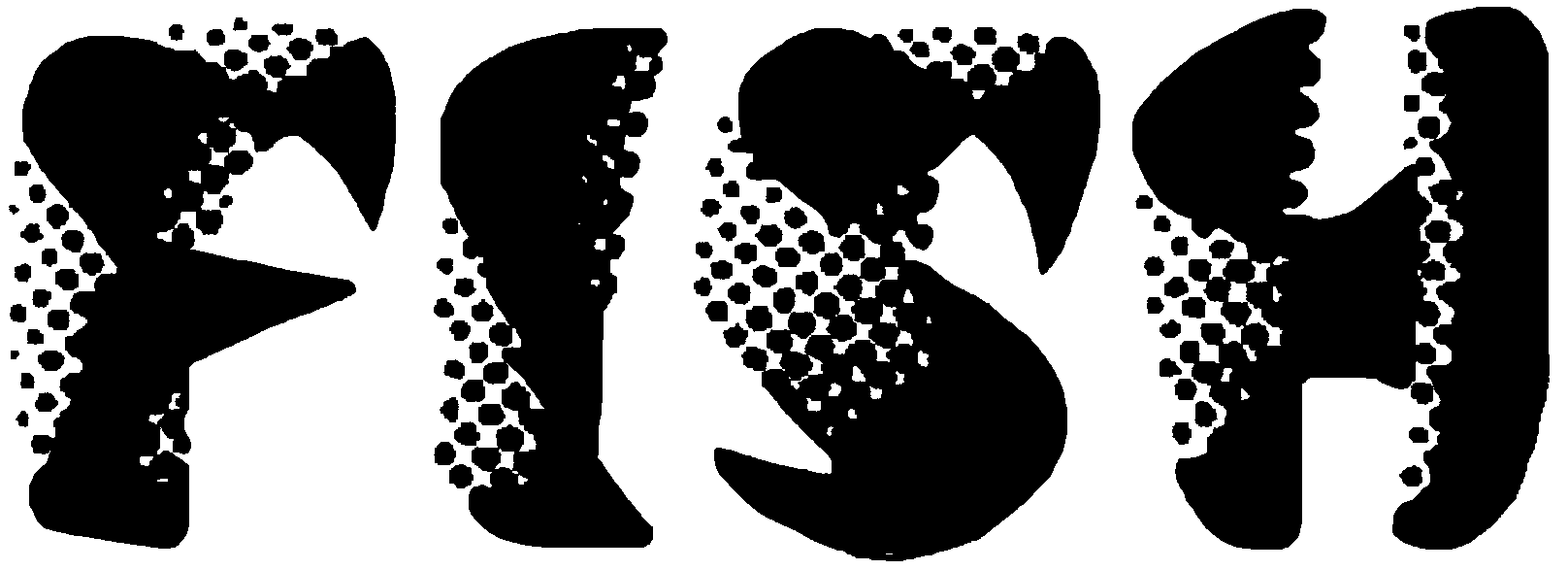
Absurdly
good gear since 1983
Rescue Type Stuff
Try some of these links for info
on rope rescue stuff including rope data and tests.
www.pushdtp.com/trm/ar
www.pushdtp.com/trm/art/be
www.pushdtp.com/trm/art/ark
www.narc.co.uk/products/ropes
Mechanical Advantage
Mechanical advantage, or hauling
more weight with less work by means of some system, is one of
the best things you can learn. With this you can haul your pig
on El Cap, retrieve a partner who can no longer move under their
own power, or do some nifty yardwork tricks. My bad drawings below
will get you going on the basic idea. There are numerous ways
to set up these systems, yet all give the same effect. For some
fine reading on these systems and way more, see Wilderness
Search and Rescue, by Tim Setnicka.
Paraphrased from the book, Wilderness Search and
Rescue:
For the below drawings we will consider the pulley systems in
a state of equilibrium. Equilibrium is when a pulley system under
load is not moving; the forces trying to raise the load are equal
to the load. These theoretical pulley arrangements have no friction
in the pulleys or elsewhere. In reality however, there is a tremendous
difference between trying to raise a load with a 3:1 system using
efficient pulleys and one using only carabiners.
| Pulley |
Pulley Factor |
Actual Mech.
Advantage |
Theoretical
Advantage |
| carabiner |
.66 |
1:.98 |
3:1 |
| cheapo pulley |
.75 |
2:.42 |
3:1 |
| rescue pulley |
.93 |
2:.79 |
3:1 |
| frictionless |
1.00 |
3:1 |
3:1 |
(note: these are numbers from 1977. YMMV)
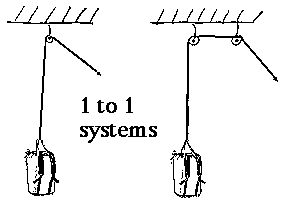
If any load (use 100lbs as an example) is fully
supported by a rope, it represents a 1:1 system. It will take
100 lbs of pull to keep the load in equilibrium.
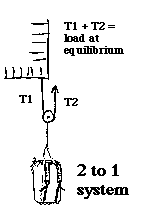 Each portion of the rope on
either side of the pulley is supporting half the weight of the
load. It is the continuity of the rope around the pulley that
equalizes forces T1 and T2. the reason each side of the rope takes
half the load is because they coordinate movement. In any mechanical
advantage system, it is the continuity of one rope going around
the all the pulleys that automatically coordinates the distribution
of the load. This is the fundamental concept behind pulley use.
Since the system is in equilibrium, it is easy to see that if
one more pound of force were added to T2, the system would be
out of equilibrium and the load would slowly begin to rise. At
equilibrium the rope tension always equals the load.
Each portion of the rope on
either side of the pulley is supporting half the weight of the
load. It is the continuity of the rope around the pulley that
equalizes forces T1 and T2. the reason each side of the rope takes
half the load is because they coordinate movement. In any mechanical
advantage system, it is the continuity of one rope going around
the all the pulleys that automatically coordinates the distribution
of the load. This is the fundamental concept behind pulley use.
Since the system is in equilibrium, it is easy to see that if
one more pound of force were added to T2, the system would be
out of equilibrium and the load would slowly begin to rise. At
equilibrium the rope tension always equals the load.
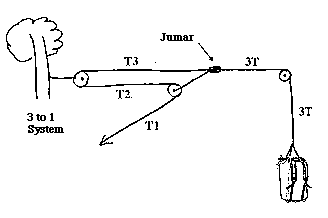
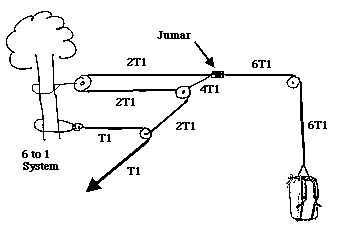
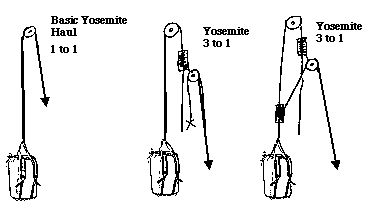 Of note is when you are using a mechanical advantage
system, there is a lot more force being applied to some part of
that system than it would seem. It is very important to know what
that force is doing on the other end of the rope... for example:
You are raising your unconscious partner with a 3:1 or higher
pulley system. You are yarding away and barely notice the the
hauling got a bit harder for a second.... no problem you pull
a bit harder and then the hauling is normal again...guess what,
his head got wedged in fissure and has now popped off...yep, you
pulled his head clean off. Could happen. I once set up a free
air haul with a mechanical advantage to help raise some really
heavy bags on El Cap. The bags got hung up under a small roof.
I pulled and pulled....finally something gave...it was the sheath
on the haul rope, below the system I had set up. Not a pretty
sight on day one..... No way I could have done this without the
mechanical advantage.... but, with the set-up, it was not very
hard to do.
Of note is when you are using a mechanical advantage
system, there is a lot more force being applied to some part of
that system than it would seem. It is very important to know what
that force is doing on the other end of the rope... for example:
You are raising your unconscious partner with a 3:1 or higher
pulley system. You are yarding away and barely notice the the
hauling got a bit harder for a second.... no problem you pull
a bit harder and then the hauling is normal again...guess what,
his head got wedged in fissure and has now popped off...yep, you
pulled his head clean off. Could happen. I once set up a free
air haul with a mechanical advantage to help raise some really
heavy bags on El Cap. The bags got hung up under a small roof.
I pulled and pulled....finally something gave...it was the sheath
on the haul rope, below the system I had set up. Not a pretty
sight on day one..... No way I could have done this without the
mechanical advantage.... but, with the set-up, it was not very
hard to do.


 Each portion of the rope on
either side of the pulley is supporting half the weight of the
load. It is the continuity of the rope around the pulley that
equalizes forces T1 and T2. the reason each side of the rope takes
half the load is because they coordinate movement. In any mechanical
advantage system, it is the continuity of one rope going around
the all the pulleys that automatically coordinates the distribution
of the load. This is the fundamental concept behind pulley use.
Since the system is in equilibrium, it is easy to see that if
one more pound of force were added to T2, the system would be
out of equilibrium and the load would slowly begin to rise. At
equilibrium the rope tension always equals the load.
Each portion of the rope on
either side of the pulley is supporting half the weight of the
load. It is the continuity of the rope around the pulley that
equalizes forces T1 and T2. the reason each side of the rope takes
half the load is because they coordinate movement. In any mechanical
advantage system, it is the continuity of one rope going around
the all the pulleys that automatically coordinates the distribution
of the load. This is the fundamental concept behind pulley use.
Since the system is in equilibrium, it is easy to see that if
one more pound of force were added to T2, the system would be
out of equilibrium and the load would slowly begin to rise. At
equilibrium the rope tension always equals the load.

